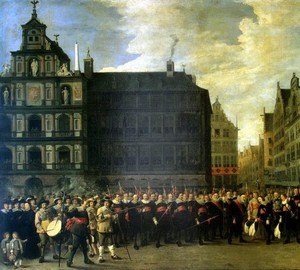
Description of the picture:
Group portrait of members of the rifle guild in Antwerp – David Teniers the Younger. 1643. Wood, oil. 133×184.5
The Hermitage painting was Teniers’ first large commissioned work and was intended for the assembly hall in the riflemen’s guild house. She was in this building until 1749, but then, due to the financial difficulties of the guild, the canvas of Teniers the Younger (along with the Crowning of the Winner by Rubens, now stored in the Kassel Gallery) was sold to the Dutch artist Gerard Hoot.
The action takes place on the Grotto Markt – the main square of Antwerp. The town hall is visible on the left (1561-1565, architect K. Floris). The artist shows the rigor and simplicity of the right wing of the building, which contrasts with the central protruding part of the facade, rich in decorative details and energetic in plastic. The left side of the town hall, cut off by the frame, is not visible. A giant three-story pediment, twin columns, niches decorated with statues of the “Madonna and Child on the Crescent” (apparently the Immaculate Conception ”),“ Justice ”and“ Wisdom ”- all this gives the impression of an extraordinary richness of architectural forms. The accuracy and thoroughness of the execution of the smallest details Teniers as if expresses his respectful attitude to the monument to the power of Antwerp. To the right of the town hall is Zilversmidstraat (Silver Craftsmen) Street with buildings of the 16th century. In the building on the far right (Huys van Spanien Spanish House), whose facade is decorated with a red canvas with coats of arms, was the Oude Voetboog guild, organized in the 15th century.
Creating this large canvas, Teniers did not resort to the help of other masters. Unlike artists of the architectural genre (in particular, painters from the Van Stenwijk family or the Neffs family) who specialized in depicting the interiors and exteriors of churches, Teniers himself painted both an architectural background and portraits. In Teniers’ painting, the foreground figures and architecture are so organically related to each other that they are perceived as inextricable parts of the whole. Through the window openings of the town hall, figures are also visible that visually contribute to the unity of the work. Thanks to the well-balanced proportionality, a person is in harmony with architecture. Therefore, the characters of Teniers do not seem lost in the crowd.
Various assumptions were expressed about the plot of this work. For example, van der Branden (1883) believed that a parade on the occasion of the anniversary of the Dean of the Guild of Godevard Sieiders was presented on canvas. According to Klinge (1991), the definition of the plot made by van den Branden is hardly valid because of the lack of documentary evidence. She, like Delen (1930), rightly notes that a parade takes place on the square in Antwerp, the oldest guild “Oude Vbetboog”, its dean, as a rule, was the mayor of the city. Guild members are depicted in black suits with red belts. Three older characters (probably guild leaders) have a red ribbon tied over their shoulders. In order to diversify the monotony of black spots and saturate the picture with color, Teniers portrayed some representatives of the guild in yellow costumes (in particular, the drummer and standard bearer)."